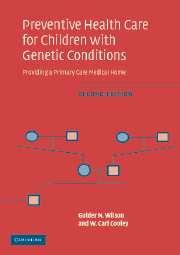Book contents
- Frontmatter
- Contents
- Preface
- Glossary of genetic and molecular terms
- Part I Approach to the child with special needs
- Part II The management of selected single congenital anomalies and associations
- Part III Chromosomal syndromes
- Part IV Syndromes remarkable for altered growth
- Part V Management of craniofacial syndromes
- 14 Craniosynostosis syndromes
- 15 Branchial arch and face/limb syndromes
- Part VI Management of connective tissue and integumentary syndromes
- Part VII The management of neurologic and neurodegenerative syndromes
- Part VIII Management of neurodegenerative metabolic disorders
- References
- Index
15 - Branchial arch and face/limb syndromes
Published online by Cambridge University Press: 29 January 2010
- Frontmatter
- Contents
- Preface
- Glossary of genetic and molecular terms
- Part I Approach to the child with special needs
- Part II The management of selected single congenital anomalies and associations
- Part III Chromosomal syndromes
- Part IV Syndromes remarkable for altered growth
- Part V Management of craniofacial syndromes
- 14 Craniosynostosis syndromes
- 15 Branchial arch and face/limb syndromes
- Part VI Management of connective tissue and integumentary syndromes
- Part VII The management of neurologic and neurodegenerative syndromes
- Part VIII Management of neurodegenerative metabolic disorders
- References
- Index
Summary
Branchial arch syndromes
Branchial arches are critical for the development of the lower portion of the craniofacies, the muscles of the pharynx and jaw, the cardiac conotruncal region, and the salivary, thymus, and parathyroid glands. In addition, branchial arch mesoderm merges with neural crest cells to form an ectomesenchyme that is important for the development of the cranial nerves. The embryonic derivatives of the branchial arches explain the anomalies seen in children with branchial arch syndromes: craniofacial anomalies of the mandible, maxilla, palate and ears; palatal, salivary gland, and pharyngeal muscle hypoplasias that cause oromotor dysfunction and feeding difficulties; and cranial nerve, optic, otic, and cardiac anomalies that include neurosensory and cognitive deficits. Preventive management is enormously important for children with branchial arch syndromes, since many of their feeding, neurosensory, and learning problems can be anticipated and treated.
Table 15.1 summarizes the clinical manifestations of several branchial arch syndromes. The Goldenhar syndrome-hemifacial microsomia spectrum is the most common, and will be discussed in detail after a review of other branchial arch syndromes.
Branchio-oculo-facial syndrome
Hall first described in 1983 an autosomal-dominant (AD) syndrome consisting of hemangiomatous branchial clefts, eye anomalies, nasolacrimal duct obstruction, and occasion limb or renal anomalies (Jones, 1997, pp. 246–7, Gorlin et al., 2001, pp. 895ndash;7). The branchial clefts may appear as cysts, fistulas, hemangiomas, or cutis aplasia in the lateral neck region, and some patients have had upper lip clefts.
- Type
- Chapter
- Information
- Preventive Health Care for Children with Genetic ConditionsProviding a Primary Care Medical Home, pp. 388 - 410Publisher: Cambridge University PressPrint publication year: 2006



